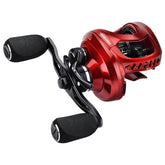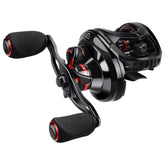
How To Select The Best Gear Ratio For Inshore Saltwater Baitcaster Reels
When baitcasting for saltwater fish, it's essential to select the gear ratio that will work best for the type of fishing you're doing. Heavier lures and lines require a slower gear ratio, while lighter baits can be fished with a faster gear ratio. In this article, we'll discuss the different factors you need to consider when selecting a baitcaster reel for inshore saltwater fishing. 
Factor#1 - What Type Of Fishing You Need To Do?
The first factor to consider is the type of fishing you'll be doing. If you're mostly fishing for baitfish or smaller lures, then a faster gear ratio baitcaster reel will be fine. However, if you're targeting larger fish such as snapper, groupers, or tarpon, then you'll need a baitcaster reel with a slower gear ratio. This will give you the power and control you need to fight these larger fish.
Factor #2 - The Weight Of Your Lure Or bait
The second factor to consider is the weight of your lure or bait. Heavier lures require a slower gear ratio in order to cast them properly. If you're using a baitcaster reel with a fast gear ratio, you'll likely end up getting "bird's nests" in your line. On the other hand, lighter lures can be cast with baitcaster reels that have faster gear ratios.
Factor # 3 - The Type Of Line You're Using
The type of line you're using will have a big impact on the gear ratio you need. For example, if you're using a heavier braid or monofilament line, you'll need a slower gear ratio to handle the weight. On the other hand, if you're using a lighter fluorocarbon or baitfish line, you can get away with a faster gear ratio.
Factor # 4- The Type Of Lure You're Using
The type of lure you're using will also play a role in the gear ratio you need. If you're using a heavy bait like a swimbait on spinner bait, you'll need a slower gear ratio to keep it in slowly and steadily. However, if you're using a lighter bait like a jig or crankbait, you can go with a faster gear ratio to retrieve it quickly.
Factor # 5 - Your Personal Preference
At the end of the day, it's important to choose a baitcaster reel with a gear ratio that you're comfortable with. A faster gear ratio will be fine if you're mostly fishing for smaller baitfish. However, if you're targeting larger fish, you'll need a baitcaster reel with a slower gear ratio. Experiment with different gear ratios until you find one you're comfortable with.
What Does Gear Ratio Mean On A Baitcaster Reel?
The term “gear ratio” refers to how many times the spool revolves for each turn of the reel handle. baitcaster reels with a high gear ratio will revolve the spool faster, while baitcaster reels with a low gear ratio will revolve the spool more slowly. The gear ratio you choose should be based on the type of fishing you plan to do.
If you are planning to use your baitcaster reel for trolling, a low gear ratio is best. This is because when you are trolling, you are usually using a bait that does not require a lot of speed to attract fish. A slow gear ratio will also give you more control over your bait.
If you are planning to use your baitcaster reel for casting, a high gear ratio is best. This is because when you are casting, you need to generate a lot of speed to cast your bait far away from the shore. A high gear ratio will also help you retrieve your bait faster if you get a bite.
In general, baitcaster reels with a gear ratio of around 6:1 are good for trolling, while baitcaster reels with a gear ratio of around 8:1 are good for casting. Of course, there are always exceptions to this rule, and you may find that a different gear ratio works better for your particular fishing situation.
When To Use Lower Gear Ratio?
There are a few applications where using a baitcaster with a lower gear ratio can be advantageous. When fishing for large, powerful fish species like tarpon or muskie, a low gear ratio baitcaster will give you the extra torque needed to fight them. This is also true when fishing in heavy cover, where you need to make quick, hard retrieves to break your bait free from the vegetation.
When To Use Higher Gear Ratio?
In most other situations, a higher gear ratio baitcaster will be the better choice. If you're fishing for smaller fish species, or in open water where long distance casting is more important than raw power, a high gear ratio baitcaster will be the better option.
Deciding on the right gear ratio for your baitcaster reel is a personal choice, and will depend on the type of fishing you're doing. In general, though, remember that lower gear ratios are best for big fish and heavy cover, while higher gear ratios are better for small fish and open water.
Conclusion
When selecting the best gear ratio for baitcaster reels, there are a few factors you need to consider. The type of fishing you'll be doing, the weight of your lure or bait, the type of line you're using, and the type of lure you're using all play a role in determining which gear ratio is best. You'll also need to take your own personal preferences into account. Experiment with different gear ratios until you find one you're comfortable with.












